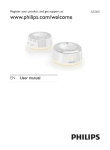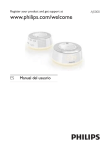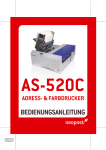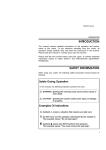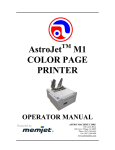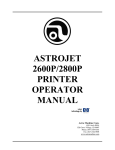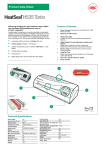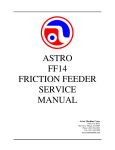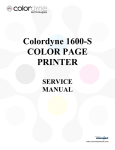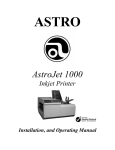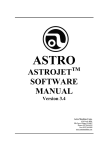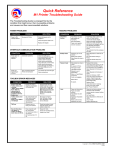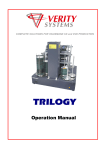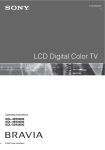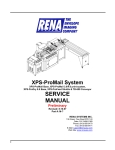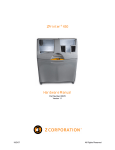Download Service Manual
Transcript
AstroJet 5000 PRINTER SERVICE MANUAL ASTRO MACHINE CORP. 630 Lively Blvd. Elk Grove Village, IL 60007 Phone: (847) 364-6363 Fax: (847) 364-9898 www.astromachine.com SAFETY PRECAUTIONS THIS EQUIPMENT PRESENTS NO PROBLEM WHEN USED PROPERLY. HOWEVER, CERTAIN SAFETY RULES SHOULD BE OBSERVED WHEN OPERATING THE ASTROJET 5000 PRINTER. BEFORE USING THE PRINTER, YOU SHOULD READ THIS MANUAL CAREFULLY AND FOLLOW THE RECOMMENDED PROCEDURES, SAFETY WARNINGS, AND INSTRUCTIONS: ü Keep hands, hair, and clothing clear of rollers and other moving parts. ü Avoid touching moving parts or materials while the machine is in use. Before clearing a jam, be sure machine mechanisms come to a stop. ü Always turn off the machine before making adjustments, cleaning the machine, or performing any maintenance covered in this manual. ü A power cord is supplied with the machine. Plug it into a properly grounded wall outlet located near the machine and easily accessible. Failure to properly ground the machine can result in sever personal injury and/or fire. ü The power cord and wall plug is the primary means of disconnecting the machine for the power supply. ü DO NOT use an adapter plug on the line cord or wall outlet. ü DO NOT remove the ground pin from the line cord. ü DO NOT route the power cord over sharp edges or trapped between furniture. ü Avoid using wall outlets that are controlled by wall switches, or shared with other equipment. ü Make sure there is no strain on the power cord caused by jamming between the equipment, walls or furniture. ü DO NOT remove covers. Covers enclose hazardous parts that should only be accessed by a qualified service representative. Report any damage of covers to your service representative. ü This machine requires periodic maintenance. Contact your authorized service representative for required service schedules. ü To prevent overheating, do not cover the vent openings. ü Use this equipment only for its intended purpose. In addition, follow any specific occupational safety and health standards for your workplace or area. This manual is intended solely for the use and information of Astro Machine Corp., its designated agents, customers, and their employees. The information in this guide was obtained from several different sources that are deemed reliable by all industry standards. To the best of our knowledge, that information is accurate in all respects. However, neither Astro Machine Corp. nor any of its agents or employees shall be responsible for any inaccuracies contained herein. AstroJet TM is a registered trademark of Astro Machine Corp. Hewlett-Packard is a registered trademark of Hewlett-Packard Corporation. Windows 98 and Windows XT are registered trademarks of Microsoft Corporation. IBM is a registered trademark of International Business Machines. All other trademarks are the property of their respective holders. All rights reserved. No part of this book may be reproduced or transmitted in any form or by any means, electronic or mechanical, including photocopying, recording, or any information storage and retrieval system, without permission in writing from the publisher TABLE OF CONTENTS Table of Contents SECTION 1 – Installation 1 Contents of Packaging Tools Requires Unpacking and Assembly Connecting the AstroJet 5000 Installing the Inkjet Cartridges Installing the Printer Driver 1 1 1 3 4 5 SECTION 2 – Trouble Shooting 9 Power Problems Interface Communication Problems Feeding Problems Software Problems 9 9 10 12 SECTION 3 – Functional Operation 13 Sequence of Operation Printer Controls Printer Driver Properties 13 14 15 SECTION 4 – Adjustments 21 Drive Belt Tension Adjustment SECTION 5 – Disassembly and Assembly Basic disassembly Replacing Separator Tips Service Disassembly Procedures Right-hand Side Cover Left-hand Side Cover Replacing Motor Drive Belt Replacing Feed Rollers Replacing Main PC Board Removing and Replacing Cleaning Station Removing the Print Engine Replacing Transport Rollers SECTION 6 – Maintenance The Inkjet Cartridge Jams in the AstroJet 5000Printer Replacing the Sheet Separators Cleaning Appendices Appendix A – ASTROJET 5000 Specifications Appendix B – Supplies and Optional Hardware Appendix C – Wiring Diagram 21 23 23 23 23 24 25 26 27 30 31 33 36 39 39 40 41 41 43 43 44 45 i TABLE OF CONTENTS NOTES ii SECTION 1 INSTALLATION Section 1 – Installation Contents of Packaging 1. ASTROJET 5000 Printer 2. AC Power Adapter 3. Parallel Cable and USB 4. Software Driver 5. Paper Guides 6. Operator Manual 7. Driver Software Disk Tools Required Tools required Standard #2 Phillips head screwdriver. Unpacking and Assembly Remove the Printer and its parts from the carton. Remove all packing tape. The screws that attach the various parts of the guides to the printer are under the tape in their respective positions. Begin by installing the Fixed Side Guide. It is held in place by two screws [1]: 1 SECTION 1 INSTALLATION Next install the Adjustable Side guide using the two screws [2] provided. Attach the Rear Paper Support using the two knobs [3] provided. NOTE: the large slots fit over the socket head screws. Install the Back Guide using the thumbscrew and washer [4] provided. The washer goes between the screw and the Rear Paper Support. 2 SECTION 1 INSTALLATION Connecting the AstroJet 5000 Plugging in the Printer Make sure that the main power switch of the Printer is in the OFF position. 1. 2. Connect the power cord from the power pack to the connector [4] at the rear of the Printer. Plug the power cord into the power pack and then plug the other end into a 115-220 Volt AC, 50/60 Hz. Grounded outlet. CAUTION USE THE POWER SUPPLY PACKED WITH THE PRINTER. DO NOT USE AN ADAPTER PLUG OR EXTENSION CORD TO CONNECT THE PRINTER TO THE WALL RECEPTACLE. DO NOT USE OUTLETS CONTROLLED BY WALL SWITCHES. DO NOT USE AN OUTLET THAT SHARES THE SAME CIRCUIT WITH LARGE ELECTRICAL MACHINES OR APPLIANCES. Connecting to the Computer The Printer has both a USB and a Parallel Port [1] connection. The two ports are located one above the other as shown. If you use the parallel printer cable from your computer plug it in and latch the two locking clips. If using a USB Port [2] plug that cable into the connector mounted below the parallel connecter. The Main Power Switch [3] should be turned on after you attach the power cord to the Power Receptacle [4] 3 SECTION 1 INSTALLATION Install the Inkjet Cartridges The AstroJet 5000 uses two ink cartridges, the HP57 Color cartridge and the HP56 or HP58 Black cartridge. Use the HP56 Black cartridge for everyday printing and the HP58 Black Cartridge for photos and high quality printing. Install and replacing the cartridge is done in the following manner: 4 1. Plug in the Printer and turn the main power switch ON. Open the top cover and press the soft power button [1], the button will light... The printhead carriage will move side to side and the printhead wiper mechanism will move to its downward position. Wait until the mechanism stops moving. Then open the two printhead latching covers [2] by lifting them from the front. 2. Inset the cartridge in their appropriate positions as shown. The color cartridge goes on the left. 3. Press down on the cartridge latches until you hear a click, and then close the machine cover. SECTION 1 INSTALLATION Installing the Printer Driver The installation procedure for the AJ5000 driver is different for USB and Parallel Ports. Follow the instructions below for installing the printer with a USB port. Instructions for installing the printer on a Parallel Port follow the instructions below. Install the disk supplied with the printer in your CD drive. If the Window’s Explorer window opens, close it. USB Port Installation 1. Connect the printer to the computer via the USB port and turn the printer ON. In a few minutes the “Welcome to the Found New Hardware wizard” will open on the computer screen. Check the box “No, not this time” as shown. Then click NEXT>. 2. The next window that opens will show the name of the printer AMC50 or AMCAMC50. Click on the “Install the software automatically (Recommended” box and then click on NEXT>. 3. After a few moments the window shown below will appear, and then the “Hardware Installation” window will appear. Click on “Continue Anyway” and the driver software will load from the disk. 5 SECTION 1 INSTALLATION 4. Once the driver is loaded the “Completing the found New Hardware Wizard” window will appear. Click FINISH. 5. The installation is complete when the “Found New Hardware” box appears in the lower right-hand corner of your screen. Parallel Port Installation 6 1. Connect the printer to the computer via the Parallel port (LPT1) and turn the printer ON. If the disk loads and the “Welcome to the Found New Hardware wizard” opens; CLOSE it. 2. Click on START and then Printers and Faxes. When the “Printers and Faxes” window opens click on Add a printer. 3. The “Welcome to the Add Printer Wizard” window will open. Click NEXT. SECTION 1 INSTALLATION 4. Click on the Local printer attach to the computer and Automatically detect and install my Plug and Play printer buttons in the “Local or Network Printer” window. Then click NEXT. 5. The “Welcome to the Found New Hardware Wizard” window will then open. Click on No, not at this time and then click NEXT. 6. In the “Found New Hardware Wizard” window that appears next, click on Install the software automatically (Recommended) button and then click NEXT. 7. The installer will look for the disk. This may take a few minutes. Then the “Please wait while the wizard installs the software…” will open as will the “Copying Files” window. 7 SECTION 1 INSTALLATION 8. After a few moments you will see the “Hardware Installation” window. Click on the Continue Anyway button to continue the installation of the software. 9. When the “Completing the Found New Hardware Wizard” window opens click FINISH. 10. The “New Printer Detection” window opens. It is a good idea to print a test page at this point to confirm that the printer driver and the printer are communicating. Load a sheet of 8-1/2” X 11” paper in the printer and click NEXT. 11. Once the test page is printed the “Completing the Add Printer Wizard” window will display information about the printer. Click FINISH to close the window. 12. Restart the computer to complete the installation. 8 SECTION 2 TROUBLE SHOOTING Section 2 – Trouble Shooting This section is arranged by first the condition that might occur, and then by possible problems, their cause and recommended solutions. Power Problems CONDITION PROBLEM Power is on, nothing happens. No power to printer SOLUTION Check that the power cord is plugged in. Check that the power outlet is live. Replace AC Adapter... Interface Communication Problems CONDITION Printer does not respond to software. PROBLEM Connection problems. SOLUTION Check that port is communicating with printer by using another parallel or USB cable, replace cable. Check cable connection to see if any of the pins are bent or missing. If so replace cable. If port cannot communicate using another parallel or USB cable, check printer. If port cannot communicate using another parallel or USB cable and the printer is OK, check parallel or USB port on the computer. Printer not responding to software Poor connection between printer and computer Turn printer off and on again. Check connections. 9 SECTION 2 TROUBLE SHOOTING Feeding Problems CONDITION Intermittent feeding Multiple feeds PROBLEM Feed ramp not used The feed ramp adds a slope to the stack and helps feeding. Side guides set improperly Loosen the side guides slightly. Dirty feed rollers Clean the feed roller with distilled water and a cloth. DO NOT use any solvents or detergents as they may damage the feed rollers. Paper stuck together Fan media before placing it in printer Uneven mail piece Tap inserts to front of envelopes and retry. Separator gap not set properly. Adjust separators to thickness of media. Media stuck together. Fan the media before loading in printer. Side guides too close to media Push side guides away from media. Brake misadjusted. Failure to feed 10 SOLUTION Adjust brake (see Section 4- Adjustments) Side guides too close to media Readjust side guides No power to printer. Check the power button is ON and that the power cord is plugged in. Feed gap too tight. Adjust separator to thickness of media Feed gap too loose Adjust separator to thickness of media. Material is out of specification. Maximum thickness is 0.0625” Motor on, feed rollers not turning. Check for broken drive belt and replace, Check for loose set screws on drive pulley or belt drive roller pulley. Clutch not engaging. Replace Clutch. Motor failure. Check that motor is receiving power from the power supply. No power See Power Problems in this Section. SECTION 2 TROUBLE SHOOTING CONDITION Jams PROBLEM SOLUTION Paper path obstruction Clear jam and remove pieces remaining under printhead. Paper not loaded properly Instruct operator in proper loading of media. Feed ramp not used properly Set feed ramp Separators improperly adjusted Adjust separators to thickness of media. Media curled or bent. Uncurl media. The separators are worn. Replace separator tip. Printing Problems CONDITION Extra lines; losing data PROBLEM Database problem Improper output (address information out of order, missfeeding, etc.) Wrong interface settings Static electricity Media jams Dirty media sensor Double feeding Media is curled or bent Media is too thin No communication Improper cabling / connector Unit not receiving power Print too light or missing character dots Blurry address Clogged or dirty printheads Running out of ink Image is not sharp Split line of type A line of type does not match up. Feeding problems Paper Light Flashes Double sheets. Miss feeds. Paper Miss Feed Cancel Light Flashes Ink Cartridge Missing SOLUTION Check data in database program Check software or data base on PC. Close the software and then turn Printer of and on. Clean media sensor. Adjust Sheet Separators on feeder. Uncurl media. The minimum thickness for media is 0.006”. Use Proper cable (see Operator Manual). Check plug connections, on/off switch and fuse on back. Replace inkjet cartridges. Replace the inkjet cartridge or change the printer resolution setting. Check media thickness. Check media thickness. The minimum thickness for material is 0.006”. Increase the resolution of the print. Adjust the sheet separator. Press the Paper button to feed the paper into position for printing. Install print cartridge. 11 SECTION 2 TROUBLE SHOOTING Software Problems Refer to the manual for the application software being used. 12 SECTION 3 FUNCTIONAL OPERATION Section 3 – Functional Operation Sequence of Operation The user prepares the printer 1. Install cartridges in proper location. 2. Uses a single piece of media to set sheet separators. 3. Loads media and adjusts the side guide to within 1/32” of media. 4. Stacks media in feeder and adjusts feed ramp. 5. Turn printer on. The user prepares the layout and creates a job 1. The user selects the database and opens the layout software such as Microsoft Word. 2. Creates a layout consisting of the variable data from the database using the merge function. 3. User then creates a layout using fixed information such as return address and adds graphics as required. 4. User saves layouts. 5. User initiates the Print function through the File menu in the program. 6. User then selects through the printer driver properties menu paper size and desired print resolution. 7. User then clicks on the print button to print the job. Printing the Job. 1. As soon as enough of the job is sent from the computer to the printer, the soft power button will begin to blink. If this is the first job of the day, the printheads will automatically start the cleaning function. Once this is complete the printer will begin to feed paper. 2. After the media travels to the printer, the paper sensor will detect the lead edge of the paper and will then stop the feeding and line up the lead edge of the paper with the printheads. 3. The printheads then begin to move across the paper printing the job. After each pass the paper is advanced by the paper feed clutch to continue the printing. 4. When the first piece is printed it is ejected and the next piece is moved into position and aligned for printing. 5. When the last piece in the job is printed the printer ejects it and any pieces waiting to be printed. 6. The printheads return to the capping station and remain there until the next job is sent. Printing The print engine consists of two printheads mounted on a movable shuttle. One printhead is three colors (Cyan, Magenta and Yellow) and the other is Black to provide full color CMYK printing. The printing and operation of the printer is controlled by the single main circuit board. 13 SECTION 3 FUNCTIONAL OPERATION Printer Functional Description 1. A photosensor located on the printhead carriage sees the lead edge of the paper, sends a signal to the driver motor to reverse and align the paper with the printhead carriage, and sends a signal to the print engine on the main board that the mailing piece is ready for printing. The feed clutch remains disengaged as long as a mailing piece is in view of the photosensor. 2. When the mailing piece uncovers the sensor the clutch engages the feed rollers and the next piece of media starts moving toward the printer section. 3. This cycle repeats itself as long as there is media in the feeder. 4. Either the cycle stops when the feeder runs out of media, the operator stops the process, or there are no records remain to be printed. 5. When there are no records to be printed, the printer ejects any paper that is in line for printing. The feed clutch is off at this point. Cartridge Cleaning The cartridges are cleaned at the beginning of each startup of a job by the cleaning station and at times during a run that is determined by the printer software. A separate motor operates the cleaning station. Printer Controls The printer controls and their functions are as follows: Main Power Connection and ON/OFF Switch The AC Power Adapter provides the proper voltage to the printer. The Main Power Switch powers up the printer when it is turned ON. CAUTION USE THE AC POWER ADAPTER PACKED WITH THE PRINTER. DO NOT USE AN ADAPTER PLUG OR EXTENSION CORD TO CONNECT THE ADAPTER TO THE WALL RECEPTACLE. DO NOT USE OUTLETS CONTROLLED BY WALL SWITCHES. DO NOT USE AN OUTLET THAT SHARES THE SAME CIRCUIT WITH LARGE ELECTRICAL MACHINES OR APPLIANCES. Clear Machine Button This button operates the main drive motor to help clear paper from the printer. 14 SECTION 3 FUNCTIONAL OPERATION Soft Power Button Pressing and holding this button will reset the printer’s software. This button glows a steady green when the printer is ready and blinks when the job is sent to the printer and it is printing. Paper Switch and Cancel Switch The Paper Switch light blinks if the next piece does not feed into position properly. Press the switch to resume feeding. The Cancel Switch when pressed will cancel the job. If the light on this switch blinks it means that the printer is out of ink or a cartridge is missing. You must have both the color and black cartridge in the printer even if you are not printing in color. Printer Driver Properties The Printer Driver for the AstroJet 5000 works the same as any other Printer Driver for Windows. It does, however have some enhancements to help you maximize the ability of the printer to print variable addressed quickly and efficiently. Once the job is set up Click on File, and then on Print. The widow on the right will open. 15 SECTION 3 FUNCTIONAL OPERATION Paper/Quality Tab If you then click on the Properties button, the “Properties” window will open. Click on Size is box to select the size of the material to be printed. You can enter up to five custom sizes if the paper size you are printing on is not listed. The next step is to click on the Paper Length box to select either Automatic Detection or Select from above. Automatic Detection will cause the printer to feed one sheet of paper and measure its length. The printer will then use this information for each succeeding sheet. The first sheet is not printed. Select from above allows you to pick the paper size from the Size is box and the first sheet will be printed. The Type is box allows you to select the type of paper you are going to print. Some settings such as Photo Paper, Glossy will adjust the printing mode in the software to account for the quality of the paper. 16 SECTION 3 FUNCTIONAL OPERATION Print Quality refers to the amount of ink and the resolution of the image the printer will print. Fast Draft uses the least amount of ink, has the lowest resolution and prints the fastest. It is equivalent to 300 dpi (dots per inch). Fast Normal and Normal are approximately 600 dpi and print slower, but at a higher quality. The Best setting is approximately 1200 dpi and is used where high quality images are required. Finally, there is the Maximum DPI setting. This setting is used when printing photos and has a correction routine available under the Real Life Digital Photography button to help improve the quality of photos you print. On this and subsequent pages in the Properties window you will notice at the top the Print Task Quick Sets menu. This menu contains some standard setups for printing different types of jobs. You may also add job setups to this menu by typing in a description or name for a job and clicking on the Save button. This is particularly useful if you have some standard jobs you run all the time. Highlighting the job and clicking the Delete button will cancel any of the jobs in the menu. Finishing Tab The Finishing tab give you the option of printing more than one page on a single page or printing a large single page over several sheets of paper to make a sign or poster. To print more than one page on a single page, click on the Pages per sheet menu and select the number of pages you wish to print. This option works with multiple page documents. The default is one. The Poster printing option works just the opposite way. If you wish to make a document larger use this option to select the size of the printed document. The default for this option is OFF. 17 SECTION 3 FUNCTIONAL OPERATION Effects Tab The Effects tab gives you additional options for print size. You can use the Print document on option to specify a particular size of paper that you want to print on regardless of the size of the original document. The printer will reduce or enlarge the output to match the document. If you select % of normal size the printer will print the document in the size you selected regardless of the size of the paper. The Watermarks option prints a light background watermark in the paper while printing the original document. When this option is selected the First page only option will let you print the watermark on the first page, but not subsequent pages. The Edit button takes you to a second window that allows customization of the watermark, including font selection, color, density and you can also create you own watermark. Basics Tab The two important facts that you should be aware of with the Basics tab window are the Orientation should always be set to Portrait, never Landscape and under Page order if you are printing a merged data base, Front to back prints the last record first and Back to front prints the first record first. The Back to front is the fastest way to print database records. Copies, has a default of 1, buy you can select as many copies per document as you require. The Collate box will keep each set separate as it is printed. If you check the Show print preview box a window will open before the printing starts so that you can see the document as it will be printed. This box has options to view the pages, start the printing or cancel the job. The Advanced features option on the right gives you control over Ink volume which can be used to put less ink on the paper to help drying on less porous stock. The Dry time option will hold the printout until the dry time has elapsed and then print the next record. The last option in this window is the Low memory mode. Checking this box will manage the memory in your computer to print a large job if you do not have enough computer memory. This box should be left unchecked unless you really need it. 18 SECTION 3 FUNCTIONAL OPERATION Color Tab The Color tab helps you control the printer’s color output. If you wish to print in black only click on the Print in grayscale and select one of the three options that are available. The second option Print in sepia will print a sepia colored color image. You can not click on both the Print in grayscale and the Print in sepia boxes together. The default setting for Color space is sRGB/sYCC. The other choices are AdobeRGB and Managed by application. Unless you are familiar with or have an application that can manage the color use the default. The Advanced color settings, gives you control of the color and how it is printed. You can adjust Saturation, Brightness and Color tone. You can also adjust the individual colors with this window. This is very useful when printing color photos. The important thing to keep in mind when making changes to the standard settings in the driver is that if it can not be done you will get an error message. Service Tab The service tab allows you to perform maintenance and check functions on the printer. 19 SECTION 3 FUNCTIONAL OPERATION Clicking on the Print a Test Page button will print a sample page on the printer as shown. Clicking on the Print a Diagnostic button will print the pattern shown. When the Clean the Print Cartridge button is pressed the “Clean the Print Cartridge(s)” window appears and prints the page below. Clicking on the Intermediate Clean button will present the screen on the right. Clicking on the Prime button will take you to the next level of cleaning if necessary. When the cartridges are clean click 20 SECTION 3 FUNCTIONAL OPERATION on the Done button to exit this routine. The Display Ink Level button will show you an approximation of the amount of ink remaining in the cartridges. This only works if you start with a new cartridge and do not remove it during its use. Click OK to exit this function. The Calibrate the Device button is used to calibrate the relationship between the black and color cartridges to make sure they line up with each other. This function is usually performed whenever a new ink cartridge is installed in the printer. Click on Done when the alignment is completed or on Align to repeat this function. A copy of the print that the calibration routine prints is shown here. The Calibrate Color button has no function. Pressing it will return the window on the right. Tap 13 Tap 13 is a routine built into the printer to change the way it operates. When using tap 13, the printer will print only the number of pieces chosen. It will not eject a blank piece at the end of the run. This eliminates the last sheet being blank, but it does slow down the operation of the printer. Tap 13 feeds and prints one sheet at a time. If you choose more than one sheet they will be printed, but each sheet is fed, printed and ejected before the next sheet is fed. To initiate the Tap 13 sequence press and hold the Soft key on the front of the printer, press the Cancel key one time and then the Paper key three times. Then release the Soft key. The Cancel key light will blink twice indicating that the Tap 13 sequence is initiated. To print with this feature select the paper size you are printing on in the driver under properties and then select the “Select from Above” option. If your paper size is not listed create a custom page size. 21 SECTION 3 FUNCTIONAL OPERATION To cancel out of the Tap 13 sequence press and hold the Soft key on the front of the printer, press the Cancel key one time and then the Paper key three times. Then release the Soft key. The Paper key light will blink twice indicating that the Tap 13 sequence is off. Turning off the printer will also cancel the Tap 13 mode of operation. 22 SECTION 4 ADJUSTMENTS SECTION 4 – Adjustment ASTROJET 5000 Drive Belt Tension Adjustment REQUIREMENT: To ensure the drive belt has the proper tension. ADJUSTMENT: 1. 2. 3. 4. 5. 6. 7. Unplug the machine and remove the Left-hand side cover. (6 screws) Unplug the wires to the Switch PC Board and set the cover aside. Loosen the two screws [1] that mount the main drive motor to the frame. Move the motor up or down to obtain at between 0.085” and 0.065” deflection in the belt when a force of 1 lb. is applied as shown. Tighten the two screws [1]. Recheck the adjustment. Connect the wires to the Switch PC Board and Replace the side cover. 23 SECTION 4 ADJUSTMENTS Notes 24 SECTION 5 DISASSEMBLY – ASSEMBLY Section 5 – Disassembly – Assembly Procedures Basic Disassembly Turn off Power Disconnect Power Cord Disconnect Interface Cable Replacing the Separator Tips 1. Before replacing the separator tips, unplug the Printer. 2. Loosen the separator locking knob and raise the separator to its maximum up position. 3. Use a Phillips screwdriver and remove the screw holding the metal cover over the separator. Use the tip of the screwdriver to pry the separator tip out of its holder. 4. Replace the separator tip, reinstall the metal cover and screw. Do not over tighten. Service Disassembly Procedures WARNING THE FOLLOWING DISASSEMBLY SHOULD ONLY BE DONE BY A QUALIFIED, TRAINED SERVICE REPRESENTATIVE. CAUTION ALWAYS WEAR A WRIST STRAP THAT IS GROUNDED WHEN TOUCHING ELECTRONIC DEVICES. 25 SECTION 5 DISASSEMBLY – ASSEMBLY Right-hand Side Covers 1. Remove two screws at the top of the rear right-hand side cover. Then remove the two screws from the bottom of the cover. Then remove the cover. 2. Disconnect the Fan Power connector. Remove the two screws at the top of the front right-hand side cover. Then remove the two screws from the bottom of the cover. Carefully pull it away from the machine. NOTE: this cover fits around the cartridge storage station and provides support for the top cover. Take care when removing it. 3. Lift the top cover up and away from the pivot point on the opposite side frame. 4. Reassemble in reverse order. 26 SECTION 5 DISASSEMBLY – ASSEMBLY Components under Right-Hand Side Covers 1. Main PC Board 2. Pen Service Station 3. Forwarding Rollers 4. Main Power Inlet PC Board 5. Feed Clutch and Feed Roller Assembly Left-hand Side Cover 1. Remove the three screws at the top non-operator side cover. Then remove the three screws from the bottom of the cover. 2. Disconnect the wires attached to the Paper and Cancel Switch PC Board and the remove the cover. 27 SECTION 5 DISASSEMBLY – ASSEMBLY Major Components under Left-Hand Side Cover 1. Clear Machine Switch 2. Drive Motor 3. Roller Drive Pulley 4. Drive Belt 5. Encoder Wheel 6. Encoder Sensor Replacing Motor Drive Belt or Motor 1. Remove left-hand side cover. 2. Loosen the two motor mounting screws [1] to relieve tension on the motor drive belt. The remove the two screws [2] and the encoder sensor. NOTE: When removing the motor, disconnect the wires and remove the two mounting screws. CAUTION TAKE CARE WHEN REMOVING THE MOTOR DRIVE BELT THAT YOU DO NOT SCRATCH OR OTHERWISE DAMAGE THE ENCODER WHEEL. THE BELT HAS TO BE LIFTED OVER THIS WHEEL. 3. Carefully remove the motor drive belt by lifting it over and around the encoder wheel. 4. Replace the belt in reverse order, and then adjust the belt per the adjustment instructions in Section 4. 28 SECTION 5 DISASSEMBLY – ASSEMBLY Replacing Clutch 1. Remove rear right-hand side cover. 2. Disconnect the clutch from the wiring harness. 3. While pushing the clutch toward the pulley remove the mounting pin. 4. Remove the clutch from the feed roller shaft. 5. Reassemble in reverse order. Replacing Feed Rollers 1. Unplug the printer from the power adapter. 2. Follow the instructions above and remove the clutch before beginning the replacement of the feed and forwarding rollers. 3. Remove the left-hand side cover, disconnect the wires on the switch pc board and set aside. 29 SECTION 5 DISASSEMBLY – ASSEMBLY 4. Remove the side paper guides and the rear paper support. 5. Put the Sheet Separators in the up position and remove the two screws from each side of the separator guide assembly and remove it from the machine. 6. Remove the three screws on each side of the machine that hold the Rear Deck in place 7. Lift the Rear Deck from the machine and set aside. 8. Remove the Feed Roller Drive belt. 30 SECTION 5 DISASSEMBLY – ASSEMBLY 9. Remove the screw holding the Clutch Support Bracket and remove the bracket. 10. Remove the Feed Roller Drive pulley. 11. Next remove the washer and spring from the Feed Roller shaft. NOTE: This spring and washer keep tension on the clutch so that the pin holding the clutch remains in place. Reassemble these parts in the order removed. 12. Remove the two screws holding the Bearing Housing to the side frame. Push the Roller assembly toward you to release it from the bearing on the other side of the machine and then lift the roller and shaft assembly from the machine. 31 SECTION 5 DISASSEMBLY – ASSEMBLY 13. The two sets of forwarding rollers and shafts can be removed in the same manner as the feed rollers and shaft. Remove the bearing cap on the side frame, slide the roller and shaft toward you and lift out of the machine. 14. The rollers are attached to the shafts with Allen screws. Loosen the screws and slide the rollers off the shafts. 15. Reassemble in reverse order, taking care that the belts that drive the rollers are reinstalled during assembly. Replacing Main PC Board 1. Remove the two right hand side covers and the top cover. 2. Unplug the PC Board power cord from the Power Inlet PC Board. 3. Unplug Connector [3], the two printhead ribbon cables [2] and the cleaning station ribbon cable from the Main PC Board. CAUTION THE RIBBON CABLES CAN BE DAMAGED BY ROUGH HANDLING. TAKE CARE WHEN REMOVING THEM 4. Remove the two torque screws that attach the PC Board to the support and remove the PC Board. CAUTION MAKE SURE THAT YOU ARE PROPERLY GROUNDED WHEN HANDLING THE PC BOARD. STATIC ELECTRICITY CAN DAMAGE THIS BOARD. 32 SECTION 5 DISASSEMBLY – ASSEMBLY 5. When replacing the Main PC Board make sure that the Soft Power Button actuator is positioned properly as shown in the photo. The actuator goes around the switch on the PC Board. 6. Reassemble in reverse order. Removing and Replacing Cleaning Station 1. Remove the Main PC Board as in the steps above. 2. Move the wire harness from the PC Board mounting plate and then remove the PC Board mounting plate by removing the two screws shown. One is in the front and the other is on the top of the print engine. 3. Remove the PC Board mounting bracket support bracket by removing the two screws. 33 SECTION 5 DISASSEMBLY – ASSEMBLY 4. Remove the screw that attaches the Cleaning Station to the Print Engine. 5. Then remove the screw that attaches the Cleaning Station to the Side Frame. 6. Lift and pull the Cleaning Station away from the machine. 7. Reassemble in reverse order. Removing the Paper Length Sensor In order to remove the paper length sensor you must first remove the Main PC Board and the Cleaning Station. Once this is accomplished, the Sensor can be found on the side frame and held in place by two screws. Unplug the Sensor’s connector and remove the two screws. Remove the sensor from the frame. Reassemble in reverse order. 34 SECTION 5 DISASSEMBLY – ASSEMBLY Removing the Print Engine 1. See the instruction above and remove the side covers and the top cover. 2. Then, remove the Main PC Board and Cleaning Station. 3. Remove the four screws holding the cover over the print engine. 4. Remove the guide plate by pressing down on the plate to free it from the guide plate shaft. Then, slide it toward the feed end of the machine and remove it. 5. Lift the spring from the guide plate shaft on the right-hand side of the machine. 6. On the left-hand side of the shaft is a second spring. Lift it and remove the shaft from the machine. 7. Release the wiring harness from the clamp [2], unplug the two top wires on the clear machine switch [1] and unplug the connector on the motor [3]. 35 SECTION 5 DISASSEMBLY – ASSEMBLY 8. Unplug the connector on the encoder sensor assembly [4]. 9. Release the printhead encoder from the righthand side by pulling the end in the direction of the arrow and slip it over the notch, then releasing it from the left-hand side. CAUTION DO NOT REMOVE THE ENCODER FROM THE PRINT ENGINE ASSEMBLY. 10. Remove the frame mounting screw for the printhead carriage shaft. There is a spacer washer on the inside of the side frame between the shaft and the frame. 36 SECTION 5 DISASSEMBLY – ASSEMBLY 11. Remove the torque screw on the other end of the printhead carriage shaft. NOTE: Do not remove the shaft from the print engine assembly. When the screw is removed the support/nut can be removed from the frame. Set it aside. 12. Now remove the two screws on than attach the print engine to the frame on the left-hand side and the one screw that attaches the print engine to the right-hand frame. 13. Grasp the print engine as shown and lift it from the frame. 14. Reassemble in reverse order. Make sure that when installing the print engine the flat spring for the center guide plate rod is pointed toward the rear of the printer. DO NOT FORGET TO INSTALL THE SPACER BETWEEN THE LEFT-HAND SIDE FRAME AND THE PRINTHEAD CARRIAGE SHAFT. 37 SECTION 5 DISASSEMBLY – ASSEMBLY Replacing Transport Rollers 1. To replace the transport rollers first remove the covers, main pc board, cleaning station, and print engine. NOTE: This is to prevent damage to these parts and to give access to the transport rollers. 2. Remove the front cover by removing the two screws in the front cover and one screw on each side of the front cover on the side frames. Then lift the cover from the machine. 3. To replace the exit transport roller remove the bearing housing on the right hand side of the machine and pull the roller toward that side and lift out past the roller drive belt. 4. Removing the transport roller requires removal of the main drive belt, the encoder sensor and the encoder. 5. Remove the encoder sensor pc board [2 screws] and the encoder wheel [1 screw]. CAUTION TAKE CARE WHEN REMOVING ENCODER WHEEL. IT HAS TO BE PULLED FROM THE SHAFT. MAKE SURE IT IS NOT DAMAGED IN THE PROCESS. 38 SECTION 5 DISASSEMBLY – ASSEMBLY 6. Then remove Allen screw and the pulley from the roller shaft and the bearing on the righthand side. 7. Remove the roller. 8. Removing the forwarding roller requires removal of the pulley on the left-hand side of the machine. Remove the bearing on the righthand side of the machine and remove the roller. 9. Replace the rollers in reverse order. Make sure that the drive belts are in place when reassembling. 39 SECTION 5 DISASSEMBLY – ASSEMBLY Notes 40 SECTION 6 MAINTENANCE Section 6 - Maintenance This section covers how to care for the ink cartridges, clear paper jams, replace the sheet separators, and perform routing maintenance on the printer. The Inkjet Cartridge The AstroJet 5000 inkjet cartridges must be replaced when out of ink, when print quality is poor, or when the built in cleaning has not helped the image quality. The Approximate life of the Black number 56 inkjet cartridges based on three lines of 20 characters at 10point size per address is 20,000 addresses in the Fast Draft mode. NOTE: These figures can vary depending on the font selected. To Replace the Inkjet Cartridge: • Turn the printer on, open the top cover and press the soft key. Wait until the cartridge heads stop moving then the latch lever to release the cartridge and pull the cartridge toward you and lift it away from the holder. • Remove the new inkjet cartridge from its packaging, taking care not to touch the copper contacts, the metal plate, or the gold printhead. Remove the protective tape from the printhead. • Slide the new cartridge into its holder and latch the locking lever. • Do not force the lever into place. CAUTION NEVER SHAKE, DROP, OR HIT THE CARTRIDGE AGAINST THE PALM OF YOUR HAND OR ANY OTHER HARD SURFACE. SHAKING THE PRINT CARTRIDGE DOES NOT “MIX” THE INK AND HITTING THE CARTRIDGE AGAINST A HARD SURFACE DOES NOT CLEAR THE NOZZLES BOTH OF THESE ACTIONS ACTUALLY HURT THE PRINT QUALITY BECAUSE THEY ALLOW BUBBLES TO FORM NEAR THE INK FIRING CHAMBERS. THESE BUBBLES PREVENT THE NOZZLES FROM FIRING CAUSING WHITE STREAKS IN THE PRINT IMAGE. Storage New cartridges should be stored in their original packaging and kept away from heat. The cartridge once opened should remain in the printer. Disposal The cartridge may be disposed of in a normal manner. If there should be an ink spill, use soap and water to clean up any problem areas. Abrasive soap works well to get the ink off hands. 41 SECTION 6 MAINTENANCE Cleaning the Printhead The printheads in the AstroJet 5000 printer are cleaned automatically each time the machine is turned on or when the printer software decides they need cleaning. No operator intervention is required. Jams in the AstroJet 5000 Printer If a jam occurs, STOP the Printer. You can do this by lifting up the front cover. Some possible reasons for jamming are: 1. Feeding more than one piece of media. 2. Damaged media, such a dog-eared (turn down corners). 3. Media that is not stiff enough may not be usable. Media that meets Postal stiffness requirements for automated feeding is acceptable in the AstroJet 5000. 4. Envelopes that are caught under the flap of another envelope or stuck to one another may cause jamming. Failure to Feed Paper Stoppages If a sheet feeds, but does not get into the proper position to feed, you can clear it from the machine by pressing the Green “Clear Machine Button”. This switch will operate the drive motor and rollers, but not feed any additional paper. Removing Jammed Media It may be necessary to remove one or more of the paper guides to gain access to the jammed media. The forwarding roller guide plate can be removed by pressing down on the plate and sliding it toward the feeder end of the printer. Lift the plate out of the machine. NOTE: it is important that when this guide is removed and reinstalled it does not have any side to side play. If after installing the guide you can move it from side to side, remove it and reinstall it. The front media guide can be removed by opening the front cover, lifting the guide vertical and then lifting it out of its guide on the printhead side of the machine. 42 SECTION 6 MAINTENANCE Misfeeds Misfeeds cause the printer to stop and the Red light in the Paper Feed switch will blink. Press this switch to restart the printer and feed the sheet. If the sheets continue to fail to feed, readjust the sheet separators to the media or replace them. Replacing the Sheet Separators The sheet separators insure separation of the pieces as they are being fed. The do wear and must be replaced from time to time. If you experience double sheet feeding and can not adjust the separators to prevent it, they should be replaced. Replacement of the sheet separators is not difficult. Just follow the steps below: 1. Turn off the AstroJet 5000 and unplug it from the power source. 2. Release the separator-by loosening knob [A] and move the paper side guides to their maximum open position. 3. Lower the separators so that they touch the feed roller. 4. Remove the screw [B] and the separator support [C.] Then remove the separator [D] by prying it out of the holder. 5. Install a new separator in place and replace the separator support and screw. Cleaning The AstroJet 5000 WARNING THE PRINTER IS A PRECISION MACHINE THAT SHOULD BE CLEANED REGULARLY TO INSURE MANY YEARS OF SERVICE. BEFORE PERFORMING ANY MAINTENANCE DISCONNECT THE MACHINE FROM ITS POWER SOURCE! The Printer must be cleaned regularly of accumulated paper dust and ink. Depending on the types of media that are run, paper dust may accumulate within the printer and on the transport. Unplug the printer from the power receptacle and remove the covers. The internal areas are best cleaned with a vacuum that has a soft brush attachment to help loosen the dust particles. Take care not to damage the PC Boards or electrical wiring. The exterior of the machine may be cleaned with any standard household cleaner which is non-abrasive and does not contain plastic harming solvents. CAUTION NEVER SPRAY OR POUR CLEANERS DIRECTLY ON OR INTO THE PRINTER. EXCESS LIQUID COULD HARM ELECTRONIC PARTS. ALWAYS DAMPEN A RAG WITH THE CLEANER AND APPLY IT TO THE PARTS TO BE CLEANED. 43 SECTION 6 MAINTENANCE Feed Rollers and Forwarding Rollers The feed and forwarding rollers can become glazed with paper lint and ink from the media. They should be regularly cleaned with a mild abrasive household cleaner on a damp cloth. Avoid using solvents on the rubber rollers. 44 APPENDIX Appendix A – AstroJet 5000 Specifications PRINT TECHNOLOGY ADDRESS SPEED PRINT QUALITY (Dots Per Inch) IMAGE AREA PRINT ORIENTATION FONTS GRAPHICS, LOGOS, AND BARCODES MATERIAL SIZE MATERIAL THICKNESS FEEDER CAPACITY PRINT COLORS INK SOFTWARE FIRMWARE UPDATE PC INTERFACE DIMENSIONS WEIGHT ELECTRICAL OPTIONS Inkjet, one HP 57 Color and one HP 56 or HP 58 Black cartridge Up to 4,000 #10 envelopes per hour High Quality 1200 dpi Standard Quality 600 dpi Draft Quality 300 dpi 8.5 inches X 16 inches (215.9 mm x 406.4 mm) Portrait and Landscape All TrueType fonts available on PC Allows printing of graphics, logos, and barcodes Minimum: 3” x 5” (76 mm x 127 mm) Maximum: 11” x 17”(279.4 mm x 431.8 mm) Minimum: 0.006” (0.2 mm) Maximum: 0.0625” (1.5 mm) Up to 300 #10 envelopes HP 57 full color, HP 56 and 58 black only Water based may require drying assistance for coated stock WindowsTM Printer Drivers for WindowsTM 98, 2000, NT, ME, and XP Via PC interface in flash proms. Parallel and USB (1.1) 19.5” W x 22” L x 17.125” H (49.5 cm W x 55.9 cm L x 43.5 cm H) 40 lbs. (18.2 kg.) 115VAC or 240VAC 50/60 Hz HP Versatile fast dry Black, and Red, Blue, Green, or Yellow, Conveyor/Stacker, Drop Tray All specifications are subject to change without notice. 45 APPENDIX Appendix B – Supplies and Optional Hardware The following supply items and optional hardware are available from your Astro Machine Distributor: Supplies Black Inkjet Cartridge HP 56 Photo Black Ink Cartridge HP 58 Color Cartridge HP 57 Optional Hardware Conveyor /Stacker Drop Tray 46 APPENDIX Appendix C – Wiring Diagram 47 APPENDIX NOTES ________________________________________________________________________________ ________________________________________________________________________________ ________________________________________________________________________________ ________________________________________________________________________________ ________________________________________________________________________________ ________________________________________________________________________________ ________________________________________________________________________________ 48 Copyright © 2008 ASTRO MACHINE CORP. Elk Grove Villa/e, IL 60007 04/24/2008 Part Number: 300-AJ5000 Rev. C






















































